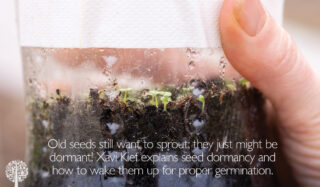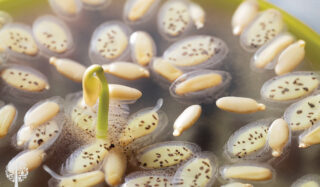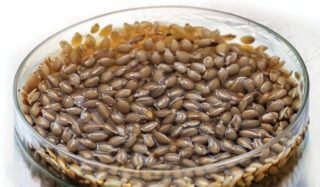Rise And Shine: Accounting For Seed Dormancy And How To Spark Germination
Although they may not look it, viable seeds are alive with the structures of future plants inside. These incredible little packages contain the genetics of their ancestors and stores of energy to make germination and the healthy growth of roots and first photosynthesizing leaves possible.
What is dormancy?
Dormancy is a state of deep rest, during which seeds remain viable and resist destruction until acceptable germination conditions are met. It can be thought of as hibernation, where the metabolism of the living seed slows, preserving its resources and protecting itself from environmental hazards.
Once a seed is in this mode, breaking dormancy is necessary to germinate. Growers have learned to improve seeding success rates by using techniques that break dormancy (if relevant) and kickstart the germination process. There is so much variation among plants regarding the anatomy of their seeds. Therefore, whether a process at the cellular level acts more as dormancy-breaking or germination-promoting is a complex topic.


Entire books have been written about seed dormancy, and researchers continue to study its mechanisms. It is especially relevant to producing commercial and food/medicine security crops, especially as the qualities of growing conditions in a given location change.
For cultivators, it is good to know that slow or low germination may not mean a whole collection of seeds is dead. They may be hedging their bets about whether it’s a good time to commit to growing!
Why do seeds go into dormancy?
Seeds enter dormancy when the plant’s continued survival depends on factors not present at seed maturity. For example, plants that grow annually, producing seeds in response to the conditions of ripening brought on by the shortening day length and lower temperatures, need their seeds to survive a cold winter before germination in a future period of warmth.
If they don’t get to grow right away, like in a controlled cultivation environment where seeds are harvested and re-planted within a few weeks, fully developed seeds enter dormancy. Generally, the longer a seed rests after maturity, the more likely it is to become dormant.
The more particular a variety of plant is about what conditions it needs to find to live also influences its tendency to go and remain dormant.
What are the types of dormancy?
Seeds of different plants undergo varied types of dormancy, and it’s not unusual to find that more than one type of dormancy is at play. How a species disperses its seeds, and the chances of finding optimal growing conditions have had evolutionary and adaptive influences on the kinds of dormancy experienced by a particular type of plant.
A simplified categorization of seed dormancy types separates them into two main categories. Endogenous (characteristics of the plant embryo) dormancy is either physical, chemical, or mechanical. Exogenous dormancy can be physiological, where the seed has germination-inhibiting qualities that must be overcome. It can also be morphological, where the seed has to finish developing the embryo before it will germinate, or a combination of the two.
How do seeds break dormancy in nature?
In nature, seeds receive signals from their environment, which influence them to leave the state of dormancy and enter stages of pre-germination, germination, and seedling growth.
Depending on the type of seed, combinations of triggers play their parts in inducing a seed to break dormancy. These include exposure to light wavelengths, temperatures (including fire!), moisture, various chemicals, and physical damage to the protective seed coat.
When should a grower actively help a seed break dormancy?
Seeds that have been dormant for long periods are usually more difficult to “convince” to break dormancy. They have characteristics that make them resilient against fluctuations in their environment that would cause false or slow starts to germination, either of which reduces the eventual plant’s likelihood of thriving.
This means older seeds may be very capable of growing but resist germination under the same conditions in which more recently harvested seeds happily sprout. Even within populations of seeds grown, harvested, processed, and stored together, some variation in dormancy has been observed. Using dormancy-breaking techniques can help ensure a more even germination rate, encouraging early development stages to occur on a similar timeline for seeds being planted simultaneously.
Most stored seeds are likely dormant, so it is wise to consider using techniques that both support rapid germination and speak loudly, telling these sleeping seeds it’s time to wake up!
Give ’em a Break
As there are different types of dormancy, various techniques exist to bring them out of slumber.
Cold stratification is when wet seeds of hot-weather annuals are exposed to temperatures between 0 and 10°C and placed in an optimized growing environment.
Warm stratification is used for plants that make spring seeds, persist through the summer heat, and then germinate and begin growth in autumn. In this case, the plants themselves go into a state of rest before growing again the following year.
Scarification is a broad term for a varied set of other dormancy-breaking and germination-enabling tactics. Coming from the root word “scar,” meaning to scratch, its name implies some intentional damage to the self-preserving structures of a seed. Scarification may allow the seed to absorb water more readily by either using physical means to break down its hard shell (sometimes called “scuffing”) or chemicals that soften or dissolve the outer parts of a seed.
Sometimes, this is a biochemical trigger, an effect of enzymes made by fungi and bacteria found in natural soil, or suggesting the presence of these species and the roots of companion host plants. Dissolved molecules containing oxygen within a soaking liquid can also have a chemical effect on a seed’s interior, genetically regulated processes.
Another type of physical scarification, known as ‘nicking’, is when a grower purposefully removes a portion of the seed’s tip to reduce the effort of root emergence.
Other dormancy-breaking interventions include subjecting seeds to temperature extremes, high-pressure applications, radiation, ultrasound, and percussion. This broad diversity of tactics makes it clear growers should employ techniques proven by research (traditional wisdom, grassroots, or academic) for the specific seed types under cultivation.
Because it acts like a starting pistol for all the seeds being treated, scarification has been linked with seeds responding well to a broader range of conditions. Energy saved in the germination process can mean more is available for robust early plant development.
This is especially beneficial in a production environment where plants of different subtypes are grown together because it simplifies scheduling and reduces duplicating tasks.
When should a grower start this process?
When working with a new package of seeds purchased from a commercial producer, it’s best to consider their suggestions for pre-treatment, germination, and planting timelines. However, if you are creatively stretching your growing season (including planting seeds of more advanced or unknown age) and can begin your new plants’ lives in a controlled environment, use dormancy-breaking tactics to artificially speed up ‘spring’ and get to summer faster!


You Break it, You Bought it
‘Buy in’ and commit to the seeds before setting the dormancy-breaking alarm. This is especially crucial if you intend to physically damage hard-shelled seeds because they will be more susceptible to pathogens. Line up the stewarded ecosystem, accounting for all elements: planting medium, air quality, temperature, lighting, moisture, and select companion species.
Don’t Hit the Snooze Button
Research shows seeds’ protective structures can transmit information about the nature of the external space. This signaling sparks reactions inside the seed: false starts communicate uncertainty and break action chains. Once these activities begin, vigorous growth with minimum delay or disruption gets seedlings off to establish themselves.
As exciting as it is to get your new little green friends ready for the garden, if they’re ready too soon, asking them to wait in small pots or under less intense lighting can be detrimental to future vitality and yields. Rapid growth is one way seedlings evade disease, outpacing exposures during periods of vulnerability and responding quickly with good immunity in later stages of life.
Reference your experience and other data about the planned grow environment to schedule stratification and/or scarification. Don’t forget to add time for hardening off if young plants will be transferred from a cozy indoor setting to a less-predictable outdoor space.
Final thoughts
Dormancy is an important factor when raising plants from seeds. As cultivators, we can learn a lot if we “think like the plants.” Seed-producing species have evolved complex mechanisms for survival through uncertainty. For our own sake, we must do the same and not assume there will always be an accessible outside source of new seeds each time a new grow is planned.
We can also never be entirely sure of our future ability to fine-tune and control growth conditions, nor that the seeds will be uniform over generations of breeding. Banking seeds in proper storage conditions, respecting and understanding the various types of dormancy, and refining techniques for breaking this state by mimicking nature are all facets of resilience.
Whether your seeds are groggy or have gone deep into suspended animation, use dormancy-breaking techniques to shake off the cobwebs and help them rise and shine!





